Jesteś nowym użytkownikiem WordPressa lub w końcu jesteś gotowy na przejście z klasycznego edytora na edytor blokowy?
Edytor blokowy WordPress jest domyślnym edytorem do pisania treści i edycji twojej witryny internetowej. Został wprowadzony w 2019 roku z przydomkiem Gutenberg i zastąpił stary klasyczny edytor.
W WPBeginner wcześnie przeszliśmy z klasycznego edytora na Gutenberg. Nasi autorzy używają edytora blokowego od lat, a po drodze nauczyliśmy się kilku cennych wskazówek i sztuczek.
Po wielu latach zabawy z edytorem bloków, mamy głębokie zrozumienie, jak efektywnie z niego korzystać.
W tym poradniku pokażemy ci, jak korzystać z edytora bloków WordPress i opanować go, aby tworzyć wizualnie oszałamiające wpisy i strony na blogu.
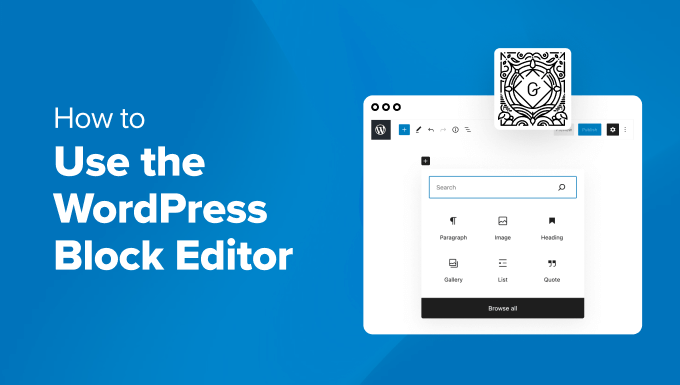
Uwaga: W tym artykule mówimy o korzystaniu z edytora bloków, który jest przeznaczony do edycji twoich wpisów i stron. Jeśli zastanawiasz się, jak edytować całą twoją witrynę internetową za pomocą bloków, zapoznaj się z naszym kompletnym przewodnikiem po pełnej edycji witryny WordPress.
Jaka jest różnica między edytorem bloków (Gutenberg) a edytorem klasycznym?
Zanim zagłębimy się w edytor bloków, porównajmy i zrozumiejmy różnice między edytorem bloków Gutenberg a starszym edytorem klasycznym.
Oto jak wyglądał klasyczny edytor w WordPress:
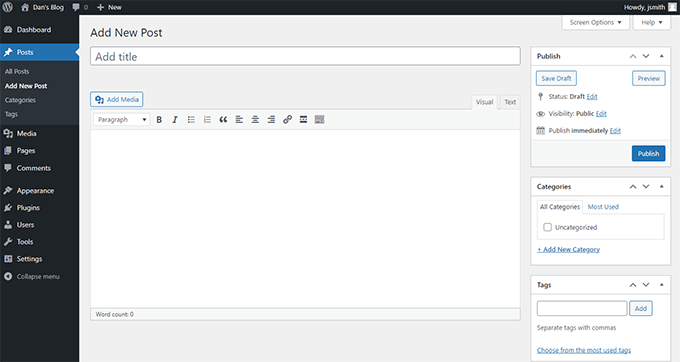
Posiadał on okno edytora tekstu z kilkoma podstawowymi opcjami formatowania. Jego funkcjonalność i wygląd były dość ograniczone.
Tak wygląda edytor bloków w WordPress:
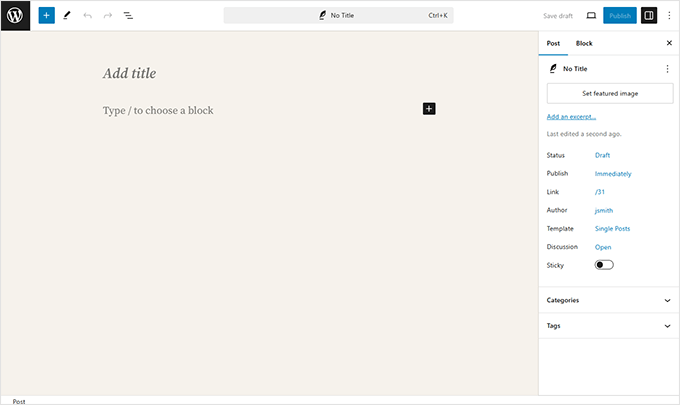
Jak widać, są to dwa zupełnie różne edytory do tworzenia treści w WordPressie.
Stary klasyczny edytor był edytorem tekstu z przyciskami formatowania podobnymi do Microsoft Word.
Nowy edytor wykorzystuje inne podejście zwane “blokami” (stąd nazwa Block Editor).
Bloki to elementy treści, które można dodawać do ekranu edycji w celu tworzenia układów. Każdy element dodany do twojego wpisu lub strony jest blokiem.
Na przykład, można dodawać bloki dla akapitów, obrazków, filmów, galerii, audio, list i innych. Istnieją bloki dla wszystkich popularnych elementów treści, a więcej można dodać za pomocą wtyczek WordPress.
W czym edytor bloków WordPress jest lepszy od klasycznego edytora?
Edytor bloków WordPress oferuje prosty sposób dodawania różnego rodzaju treści do twoich wpisów i stron.
Na przykład, jeśli wcześniej chciałeś dodać tabelę do twojej treści za pomocą klasycznego edytora, potrzebowałeś osobnej wtyczki tabeli.
Dzięki edytorowi bloków możesz po prostu dodać blok tabeli, wybrać kolumny i wiersze, a następnie rozpocząć dodawanie treści.
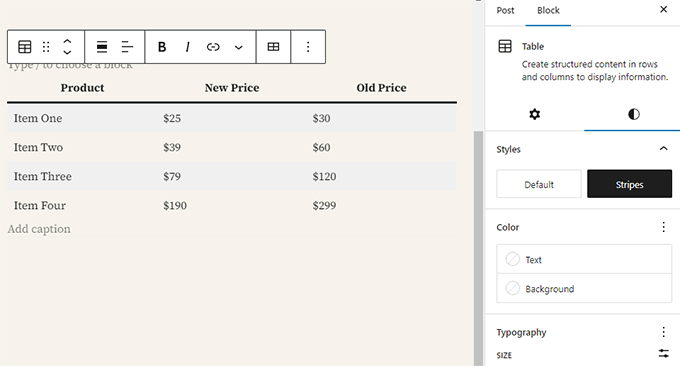
Możesz przenosić elementy treści w górę i w dół, edytować je jako pojedyncze bloki i łatwo tworzyć treści bogate w multimedia.
Co najważniejsze, edytor bloków WordPress jest łatwy w użyciu i nauce.
Daje to ogromną przewagę wszystkim początkującym użytkownikom WordPressa, którzy właśnie rozpoczynają swój pierwszy blog lub budują witrynę internetową dla majsterkowiczów.
To powiedziawszy, przyjrzyjmy się, jak korzystać z edytora bloków WordPress, aby tworzyć świetne treści jak profesjonalista.
Oto, co omówimy w tym poradniku Gutenberg:
- Using Gutenberg – The WordPress Block Editor
- Creating a New Blog Post or Page Using The Block Editor
- How to Add a Block in the Block Editor
- Working With Blocks in the New Editor
- Organizing Blocks in Groups and Columns
- Saving and Reusing Blocks in Gutenberg
- Publishing and Managing Options in Gutenberg Block Editor
- Plugin Settings in Gutenberg
- Adding Some Common Blocks in the Block Editor
- Exploring Other Content Blocks in the Block Editor
- Bonus Tips to Use Gutenberg Like a Pro
- Adding More Blocks to Gutenberg Block Editor in WordPress
- FAQs About Gutenberg – The Block Editor in WordPress
- Video Tutorial
- Bonus Resources
Gotowy? Zanurzmy się.
Korzystanie z Gutenberg – edytora bloków WordPress
Edytor bloków został zaprojektowany tak, aby był intuicyjny i elastyczny. Chociaż wygląda inaczej niż stary edytor WordPress, nadal robi wszystkie rzeczy, które można było zrobić w klasycznym edytorze.
Zacznijmy od omówienia podstawowych rzeczy, które robiłeś w klasycznym edytorze i jak są one wykonywane w edytorze bloków.
Tworzenie nowego wpisu na blogu lub strony przy użyciu edytora bloków
Rozpoczniesz tworzenie nowego wpisu na blogu lub strony w normalny sposób. Wystarczy kliknąć na menu Posty ” Dodaj nowy wpis w twoim WordPress administratorze.
Jeśli tworzysz stronę, przejdź do menu Strony ” Utwórz nową.
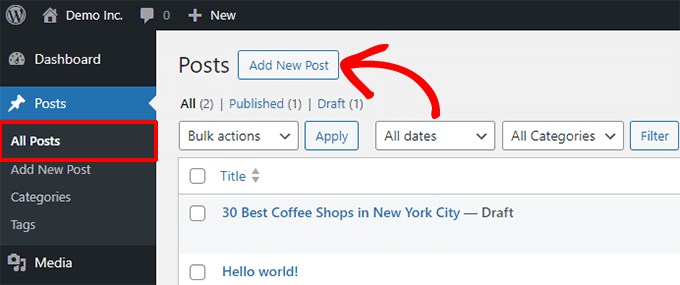
Spowoduje to uruchomienie edytora bloków.
Jak dodać blok w edytorze bloków
Pierwszym blokiem każdego wpisu lub strony jest tytuł.
Możesz użyć myszy, aby przejść poniżej tytułu lub nacisnąć klawisz Tab na twojej klawiaturze, aby przesunąć kursor w dół i rozpocząć pisanie.
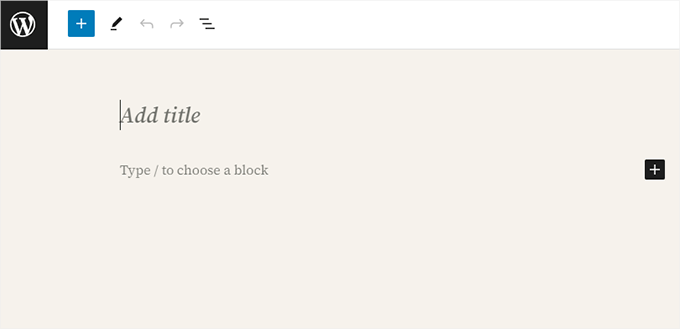
Domyślnie następnym blokiem jest blok akapitu. Pozwala to użytkownikom na natychmiastowe rozpoczęcie pisania.
Jeśli jednak chcesz dodać coś innego, możesz kliknąć przycisk Utwórz nowy blok [+] w lewym górnym rogu edytora, pod istniejącym blokiem lub po prawej stronie bloku.
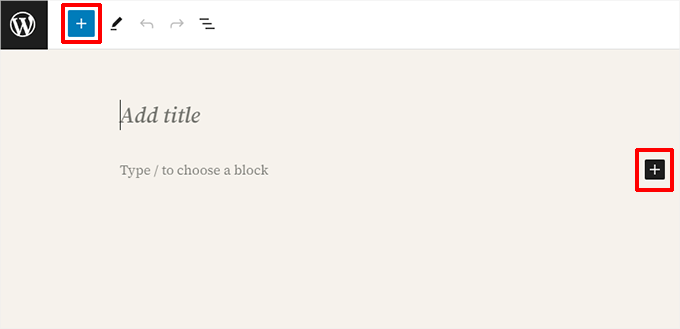
Kliknięcie przycisku spowoduje wyświetlenie menu dodawania bloków z paskiem wyszukiwania u góry i najczęściej używanymi blokami poniżej.
Możesz klikać karty, aby przeglądać kategorie bloków lub wpisać rodzaj słowa kluczowego, aby szybko wyszukać określony blok.
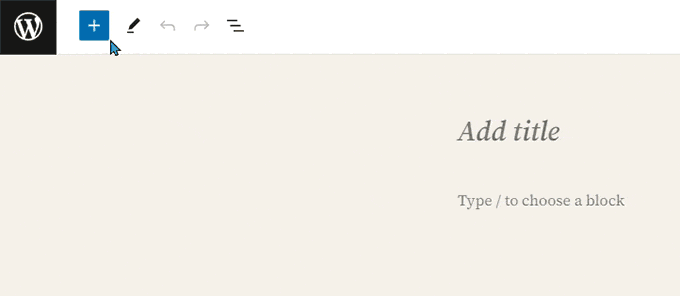
Jeśli nie chcesz używać myszy do kliknięcia przycisku, możesz również użyć skrótu klawiaturowego.
Zacznij od wpisania rodzaju /, aby wyszukać blok, a następnie wstaw go, naciskając klawisz Enter na twojej klawiaturze.
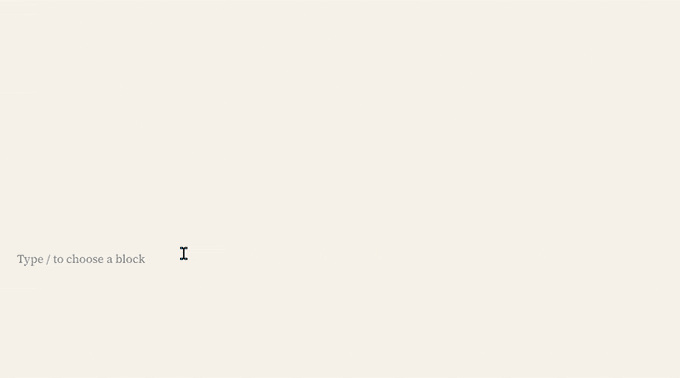
Praca z blokami w nowym edytorze
Każdy blok ma pasek narzędzi, który pojawia się na górze. Przyciski na pasku narzędzi zmieniają się w zależności od edytowanego bloku.
Na przykład, na poniższym zrzucie ekranu pracujemy nad blokiem Akapit, który pokazuje podstawowe przyciski formatowania, takie jak wyrównanie tekstu, pogrubienie, kursywa, wstawienie odnośnika i inne opcje, które są dostępne w menu z trzema kropkami.
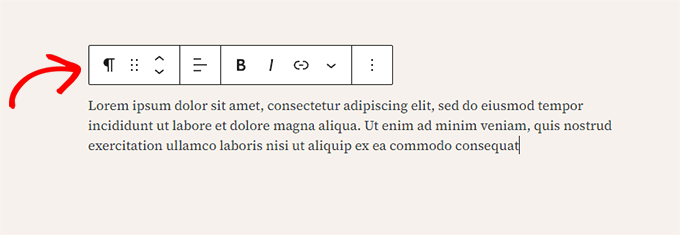
Oprócz paska narzędzi, każdy blok może mieć własne ustawienia bloku, które pojawiają się w prawej kolumnie ekranu edycji.
Ustawienia te różnią się w zależności od edytowanego bloku. Na przykład blok Akapit umożliwia edycję koloru tekstu, tła i odnośnika, a także typografii.
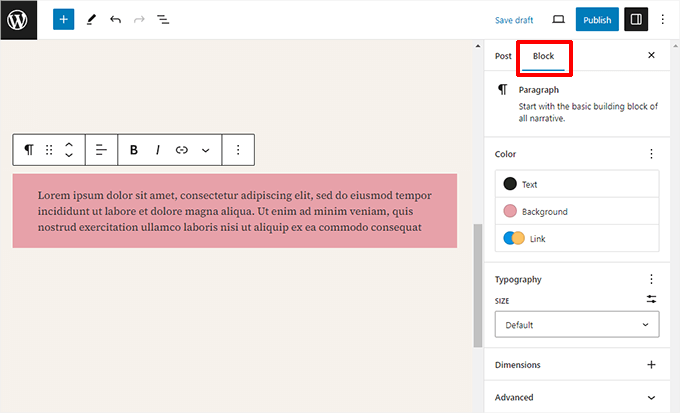
Możesz przesuwać bloki w górę i w dół oraz zmieniać ich układ.
Jeśli chcesz to zrobić, po prostu kliknij, aby przeciągnąć lub upuścić lub kliknij przyciski w górę i w dół na pasku narzędzi bloku.
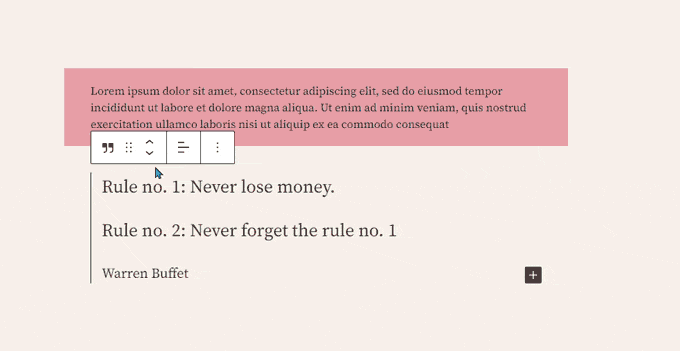
Powiązane: Zobacz nasz przewodnik, jak usuwać blok w WordPress.
Organizowanie bloków w grupach i kolumnach
Edytor bloków zawiera również przydatne narzędzia do zarządzania i organizowania twoich układów treści.
Możesz zaznaczyć wiele bloków, klikając je z wciśniętym klawiszem Shift na twojej klawiaturze.
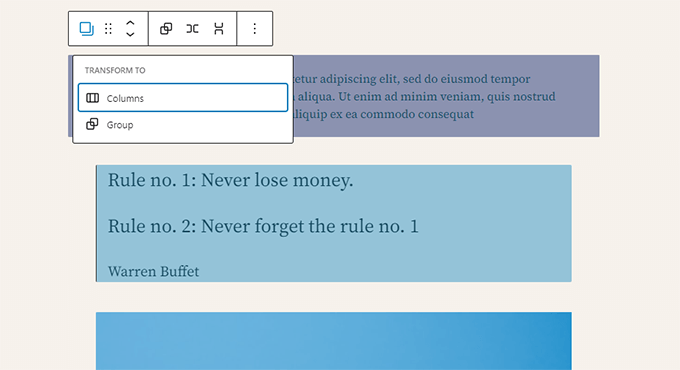
Następnie kliknij przycisk rodzaju bloku na pasku narzędzi, aby przekształcić wybrane bloki w Grupy lub Kolumny.
Następnie można zastosować style do całego bloku grupy, np. zmieniając wyrównanie lub odstępy.
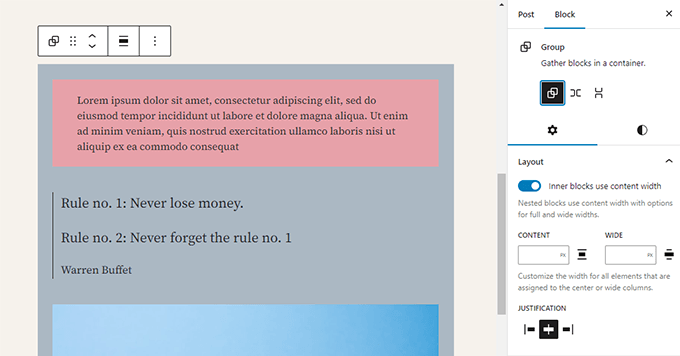
Edytor bloków umożliwia także dodanie pustego bloku Grupy lub Kolumny.
Następnie możesz wypełnić je innymi blokami.
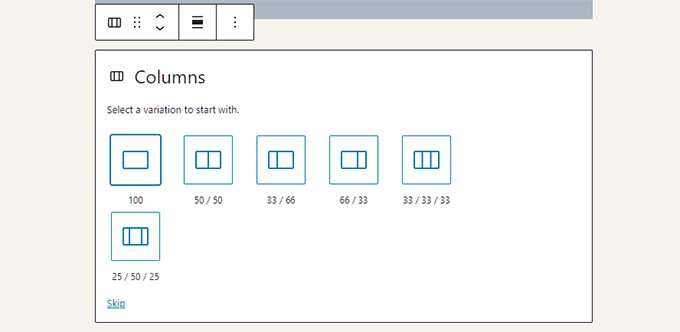
W każdej kolumnie można dodać dowolny rodzaj bloku.
Pozwala to na tworzenie 111111 pięknych układów dla różnych przypadków użycia.
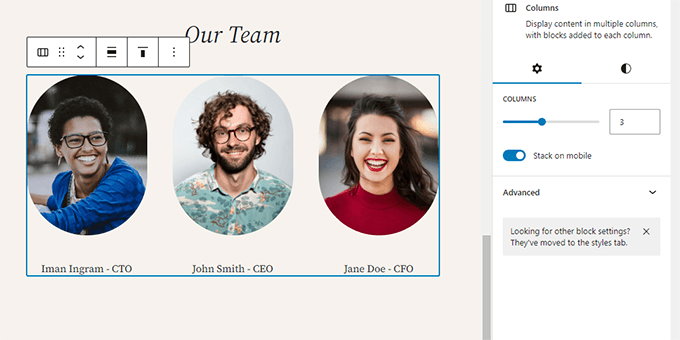
Zapisywanie i ponowne wykorzystywanie bloków w Gutenbergu
Jedną z najlepszych rzeczy w korzystaniu z bloków jest to, że można je zapisywać i ponownie wykorzystywać. Jest to szczególnie przydatne dla właścicieli witryn internetowych i blogerów, którzy często muszą dodawać określone fragmenty kodu do swoich artykułów lub stron.
Wystarczy kliknąć przycisk menu w prawym rogu paska narzędzi każdego bloku. Z menu wybierz opcję “Utwórz wzorzec”.
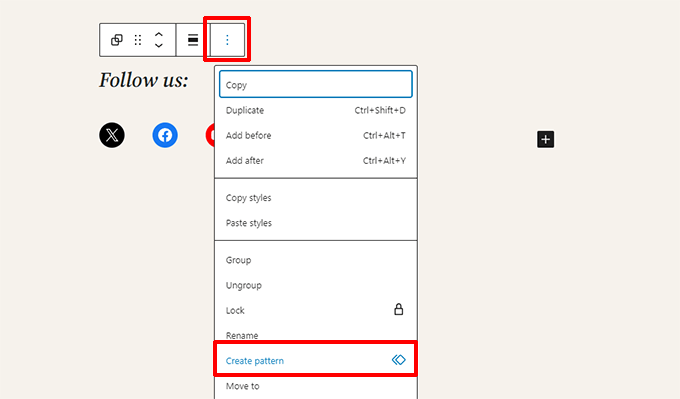
Uwaga💡: Można również używać całych grup i kolumn jako bloków wielokrotnego użycia. Pozwala to na zapisywanie całych sekcji i używanie ich w razie potrzeby.
Spowoduje to otwarcie okna, w którym należy podać nazwę tego wzorca. Może to być cokolwiek, co pomoże ci łatwo zidentyfikować, kiedy musisz go ponownie użyć.
Następnie można opcjonalnie wybrać kategorie. Pomaga to posortować twoje wzorce w zorganizowany sposób.
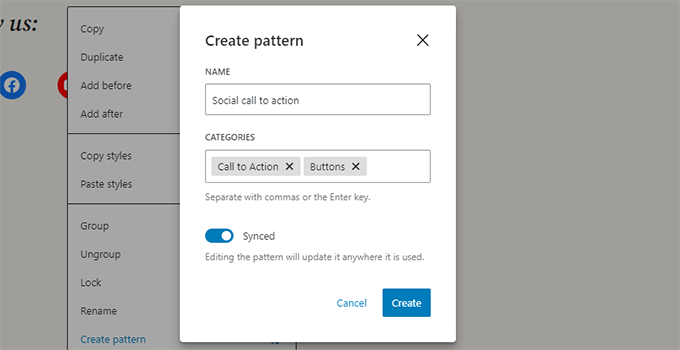
Następnie kliknij przycisk “Utwórz”, aby zapisać twój wzorzec. WordPress zapisze twój wzorzec ze wszystkimi znajdującymi się w nim blokami.
Aby ponownie użyć twojego wzorca, po prostu edytuj wpis lub stronę, na której chcesz go dodać.
Następnie kliknij przycisk dodawania bloku [+] lub użyj skrótu klawiaturowego /. Możesz znaleźć wzorzec, wpisując rodzaj nadanej mu nazwy.
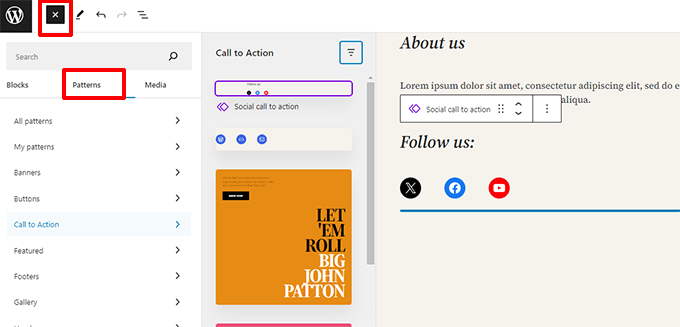
Wzorce ułatwiają właścicielom witryn dodawanie powszechnie używanych elementów do ich układów, takich jak wezwania do działania, przyciski mediów społecznościowych, banery i inne.
Twój motyw WordPress lub wtyczki mogą nawet zawierać własne wzorce lub możesz znaleźć wzorce stworzone przez innych w bibliotece WordPress Block Patterns.
Jeśli potrzebujesz więcej pomocy, przygotowaliśmy osobny przewodnik dla początkujących na temat znajdowania i używania wzorców bloków WordPress.
Publikowanie i zarządzanie opcjami w edytorze bloków Gutenberg
Każdy wpis WordPress zawiera wiele metadanych. Obejmuje to informacje takie jak data publikacji, kategorie i tagi, wyróżniające się obrazki i wiele innych.
Wszystkie te opcje są starannie umieszczone w prawej kolumnie na ekranie edytora.
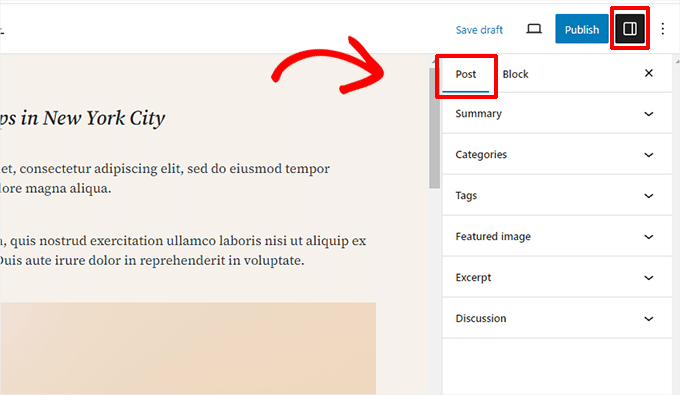
Opcje wtyczek w Gutenbergu
Wtyczki WordPress mogą korzystać z API edytora bloków, aby zintegrować swoje ustawienia na ekranie edycji.
Niektóre popularne wtyczki posiadają własne bloki.
Na przykład WPForms, najlepsza wtyczka do formularzy kontaktowych WordPress, umożliwia dodawanie formularzy do twojej treści za pomocą bloku.
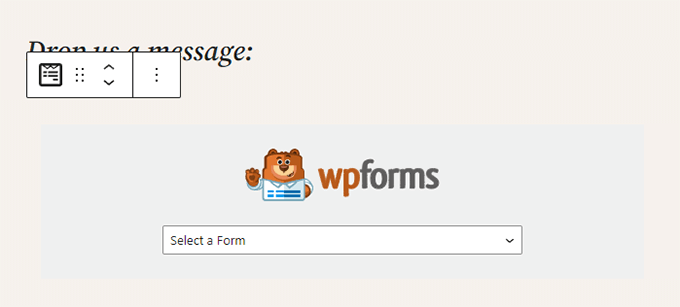
Inne wtyczki WordPress mogą również dodawać swoje ustawienia do ekranu edytora bloków.
Na przykład, oto jak All in One SEO dla WordPress pozwala edytować twoje ustawienia SEO w dolnej części edytora bloków:
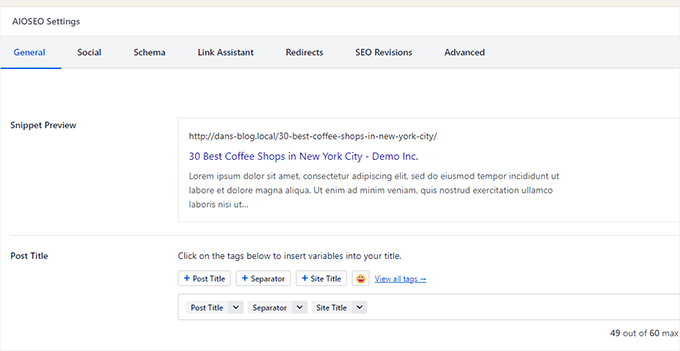
Podobnie, jeśli prowadzisz sklep internetowy za pomocą WooCommerce, to powiadomienie, że ma on również swoje własne bloki.
Bloki te umożliwiają dodawanie twoich produktów do dowolnych wpisów i stron WordPress.
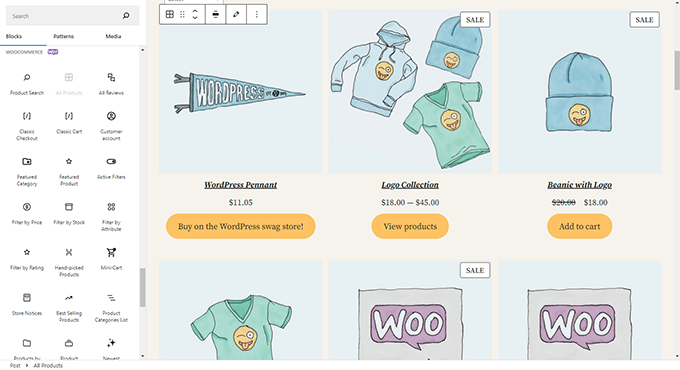
Dodawanie niektórych popularnych bloków w edytorze bloków
Edytor bloków może robić wszystko to, co starszy edytor klasyczny.
Będziesz jednak robić rzeczy szybciej i bardziej elegancko niż wcześniej. Ponadto może zrobić znacznie więcej, na przykład pozwolić ci stylizować twoją treść za pomocą wielu opcji bez kodu.
Oto niektóre z popularnych bloków, których można użyć.
1. Dodawanie obrazka w edytorze bloków WordPress
W edytorze bloków WordPress znajduje się gotowy do użycia blok Obrazek. Wystarczy dodać blok, a następnie przesłać plik z obrazkiem lub wybrać go z biblioteki multimediów.
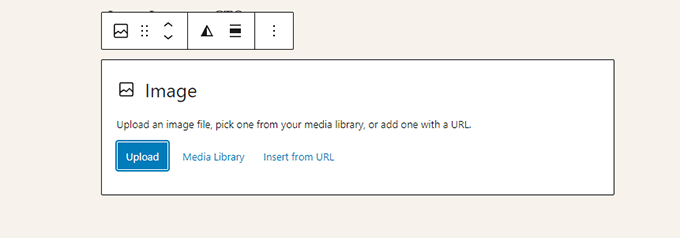
Możesz także przeciągać i upuszczać obrazki z twojego komputera, a edytor automatycznie utworzy blok Image.
Po dodaniu obrazka wyświetlone zostaną ustawienia bloku, w których można dodać metadane dla obrazka, takie jak tekst alternatywny, rozmiar rozdzielczości obrazka i dodanie odnośnika do obrazka.
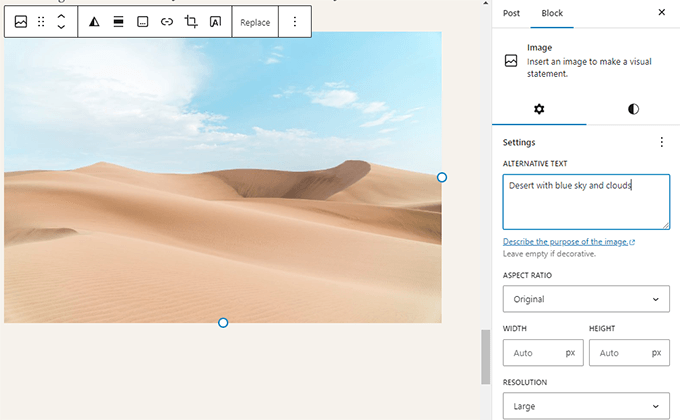
Aby uzyskać więcej informacji, wystarczy zapoznać się z naszym poradnikiem na temat dodawania obrazków w WordPressie.
2. Dodawanie odnośnika w edytorze bloków
Edytor bloków zawiera kilka bloków, w których można dodawać tekst. Najczęściej używanym jest blok Akapit, który posiada przycisk wstaw odnośnik na pasku narzędzi.
Wszystkie inne często używane bloki tekstowe również posiadają przycisk odnośnika na pasku narzędzi.

Można również wstawić odnośnik za pomocą skrótu klawiaturowego, którym jest Command + K na komputerach Mac i CTRL + K na komputerach z systemem Windows.
3. Dodawanie galerii obrazków w Gutenbergu
Blok Galeria działa podobnie jak blok obrazków. Dodajesz go, a następnie przesyłasz lub wybierasz pliki obrazków.
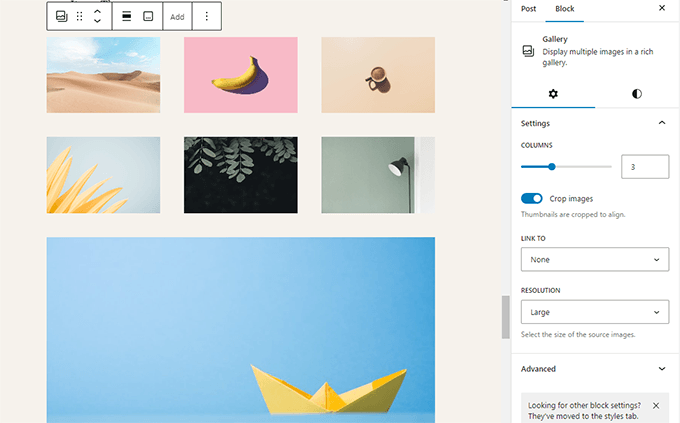
Więcej szczegółów można znaleźć w naszym przewodniku na temat tworzenia galerii obrazków w WordPress.
4. Dodawanie krótkich kodów we wpisach WordPress przy użyciu Gutenberga
Wszystkie twoje krótkie kody będą działać tak samo, jak w klasycznym edytorze. Możesz po prostu dodać je do bloku Paragraph lub użyć bloku Shortcode.
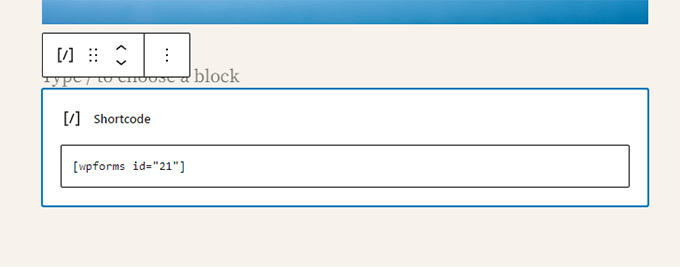
Eksplorowanie innych bloków treści w edytorze bloków
Edytor Gutenberg obiecał rozwiązać pewne długotrwałe problemy z użytecznością w WordPressie poprzez wprowadzenie nowych bloków.
Poniżej znajdują się niektóre z ulubionych, które naszym zdaniem będą niezwykle pomocne dla użytkowników.
1. Dodawanie obrazka obok tekstu w WordPressie
Wielu naszych użytkowników nie mogło umieścić obrazka obok tekstu za pomocą starego edytora. Teraz można to zrobić za pomocą bloku Media i tekst.
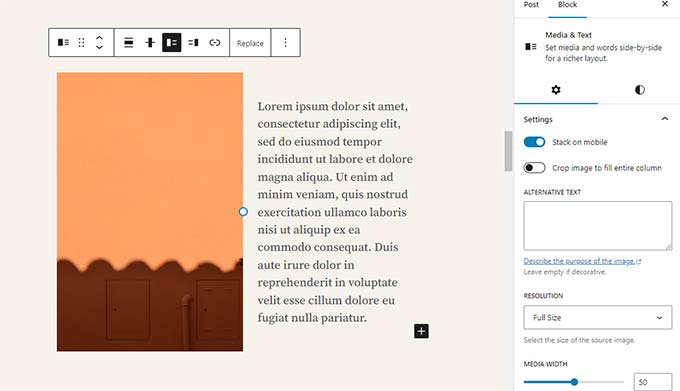
Ten prosty blok składa się z dwóch bloków umieszczonych obok siebie, umożliwiając łatwe dodanie obrazka z tekstem obok niego.
2. Dodawanie przycisku we wpisach i na stronach WordPressa
Kolejną uciążliwością starego edytora było dodawanie przycisków do twoich wpisów lub stron na blogu. Trzeba było albo użyć wtyczki, która tworzyła krótki kod dla przycisku, albo przełączyć się do trybu HTML i napisać kod.
Na szczęście Gutenberg ma blok Button, który pozwala szybko dodać przycisk do dowolnego wpisu lub strony.
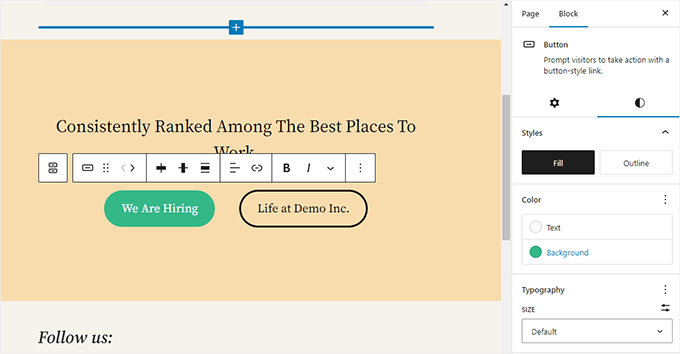
Możesz dodać odnośnik do twojego przycisku, zmienić kolory i wiele więcej. Aby uzyskać szczegółowe informacje, zobacz nasz artykuł na temat łatwego dodawania przycisków w WordPress.
3. Dodawanie pięknych obrazków w wpisach na blogu i na stronach docelowych
Inną fajną funkcją, którą warto wypróbować, jest blok okładek, który umożliwia dodawanie obrazków okładek lub kolorowych okładek tła do twoich wpisów i stron.
Obrazek okładki to szerszy obrazek często używany do nowej sekcji na stronie lub początku relacji. Wygląda 111111 pięknie i pozwala tworzyć angażujące układy treści.
Wystarczy dodać blok Okładka, a następnie przesłać obrazek, którego chcesz użyć. Możesz wybrać kolor nakładki dla okładki lub ustawić ją jako poprawiony obrazek tła, aby stworzyć efekt paralaksy, gdy użytkownicy przewijają stronę w dół.
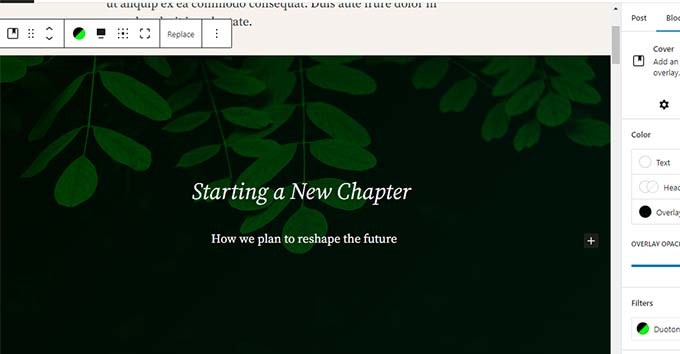
Więcej szczegółów można znaleźć w naszym artykule na temat różnicy między okładką a obrazkami wyróżniającymi w WordPress.
4. Tworzenie tabel wewnątrz artykułów
Klasyczny edytor nie miał przycisku do dodawania tabel do twoich wpisów WordPress. Trzeba było użyć wtyczki lub utworzyć tabelę, pisząc własny CSS i HTML.
Teraz edytor bloków ma domyślny blok Tabela, dzięki czemu dodawanie tabel do twoich wpisów i stron jest bardzo łatwe. Wystarczy dodać blok i wybrać liczbę kolumn i wierszy, które chcesz wstawić.

Możesz teraz rozpocząć dodawanie danych do wierszy tabeli. W razie potrzeby zawsze możesz dodać więcej wierszy i kolumn, a dostępne są dwie podstawowe opcje stylu.
5. Tworzenie treści wielokolumnowych
Tworzenie treści wielokolumnowych było kolejnym problemem, z którym klasyczny edytor w ogóle sobie nie radził.
Na szczęście edytor bloków umożliwia dodanie bloku Kolumny, który dodaje dwie kolumny bloku akapitu.
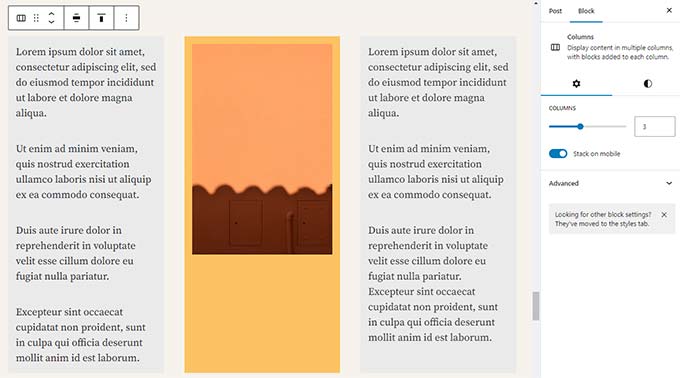
Ten blok kolumn jest dość elastyczny. Można dodać do 6 kolumn w rzędzie, a nawet użyć innych bloków wewnątrz każdej kolumny.
Dodatkowe wskazówki dotyczące korzystania z Gutenberga jak profesjonalista
Patrząc na edytor bloków, można się zastanawiać, czy nie spędzimy więcej czasu na dodawaniu i dostosowywaniu bloków niż na tworzeniu treści.
Cóż, edytor bloków jest niesamowicie szybki, a nawet bardzo podstawowe użycie przez kilka minut pozwoli ci dodawać bloki natychmiast, nawet bez zastanowienia.
Wkrótce zdasz sobie sprawę, o ile szybszy stanie się twój przepływ pracy dzięki takiemu podejściu.
Oto kilka dodatkowych wskazówek dla zaawansowanych użytkowników, które pomogą ci jeszcze szybciej pracować z edytorem bloków WordPress.
1. Przesuń pasek narzędzi bloku na górę
Być może zauważyłeś na powyższych zrzutach ekranu, że pasek narzędzi pojawia się na górze każdego bloku. Możesz przenieść ten pasek narzędzi na górę edytora.
Aby uzyskać dostęp do opcji “Górny pasek narzędzi”, kliknij przycisk z trzema kropkami w prawym górnym rogu ekranu.
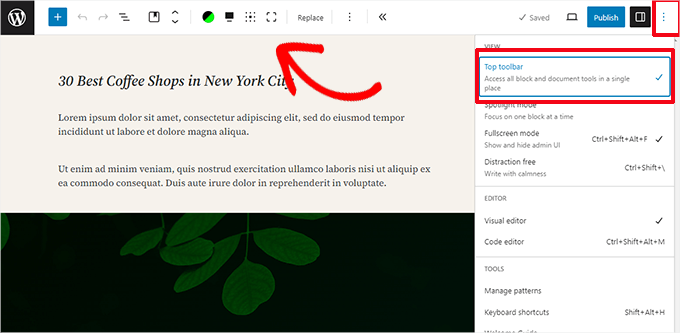
2. Używanie skrótów klawiaturowych
Gutenberg zawiera kilka przydatnych skrótów, które sprawią, że twój przepływ pracy będzie jeszcze szybszy i łatwiejszy. Pierwszym z nich, którego powinieneś zacząć używać od razu, jest /.
Po prostu wpisz /, zacznij pisać, a edytor wyświetli pasujące bloki, które możesz natychmiast dodać.
Aby uzyskać więcej skrótów, kliknij menu z trzema kropkami w prawym górnym rogu twojego ekranu i wybierz “Skróty klawiaturowe”.
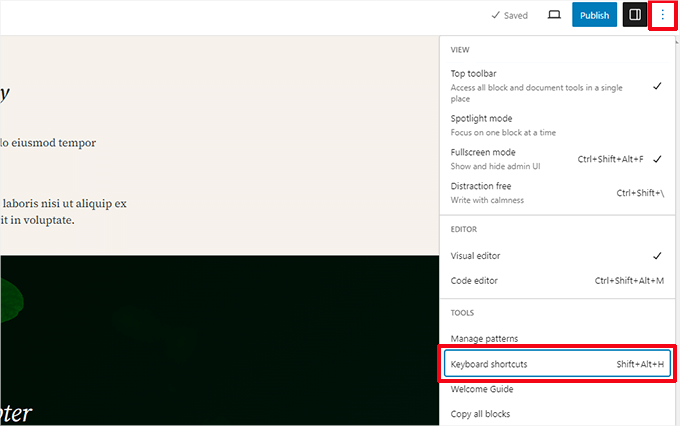
Spowoduje to wyświetlenie wyskakującego okienka z listą wszystkich skrótów klawiaturowych, których można użyć. Lista będzie zawierać różne skróty dla użytkowników systemów Windows i Mac.
3. Przeciągnij i upuść multimedia, aby automatycznie utworzyć bloki multimedialne
Gutenberg umożliwia przeciąganie i upuszczanie plików w dowolnym miejscu na ekranie, automatycznie tworząc blok dla użytkownika.
Można na przykład upuścić pojedynczy obrazek lub plik z filmem, a blok zostanie utworzony. Alternatywnie, możesz upuścić wiele plików obrazków, aby utworzyć blok galerii.
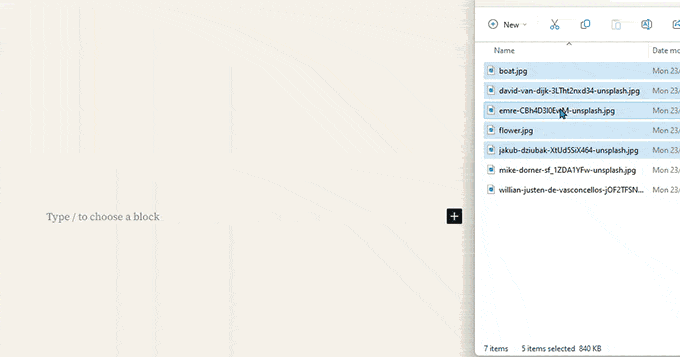
4. Osadzanie treści z YouTube, Twittera, Vimeo i innych serwisów
Edytor bloków ułatwia osadzanie treści innych firm w twojej treści WordPress. Dostępne są bloki dla wszystkich popularnych usług innych firm.
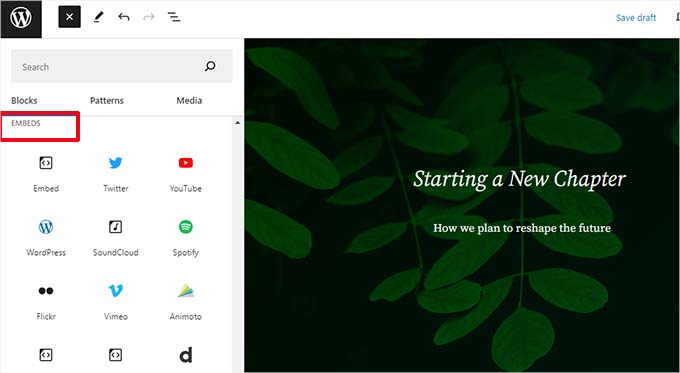
Możesz jednak po prostu skopiować i wkleić adres URL osadzania w dowolnym momencie, a blok zostanie automatycznie utworzony.
Na przykład dodanie adresu URL filmu z YouTube spowoduje automatyczne utworzenie bloku osadzania YouTube i wyświetlenie filmu.
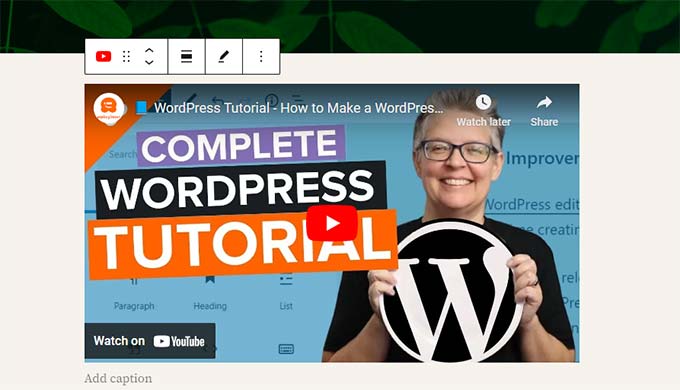
Domyślna opcja osadzania nie będzie działać w przypadku osadzania postów na Facebooku i Instagramie, ale istnieje obejście. Zobacz nasz artykuł na temat osadzania wpisów z Facebooka i Instagrama w WordPress.
Dodawanie kolejnych bloków do edytora bloków Gutenberg w WordPress
Edytor bloków w WordPress umożliwia programistom tworzenie własnych bloków. Niektóre doskonałe wtyczki WordPress oferują pakiety bloków dla nowego edytora.
Oto kilka z nich:
1. Spectra WordPress Gutenberg Blocks

Spectra WordPress Gutenberg Blocks to biblioteka bloków z wieloma zaawansowanymi blokami, które pomagają dodać więcej elementów projektu do twojej treści.
Spectra, stworzona przez ludzi stojących za popularnym motywem Astra WordPress, pomaga tworzyć 111111 piękne projekty bez pisania jakiegokolwiek kodu.
Aby uzyskać więcej informacji, zobacz naszą pełną recenzję Spectra.
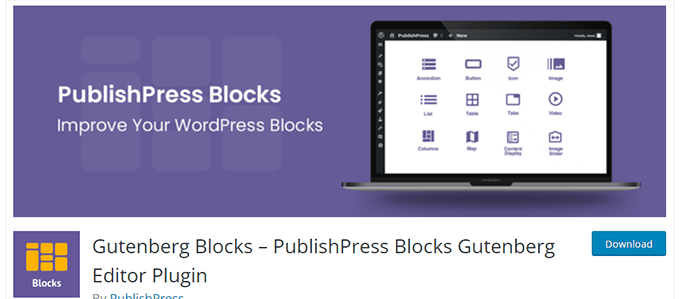
PublishPress Blocks to kolejna potężna biblioteka bloków, która zawiera dodatkowe bloki rozszerzające edytor bloków Gutenberg.
Zawiera piękne opcje układu, pokaz slajdów, przyciski, ikonki, galerie obrazków, mapy, karty, referencje, akordeony i wiele więcej.
3. Możliwość układania w stosy – bloki Gutenberg
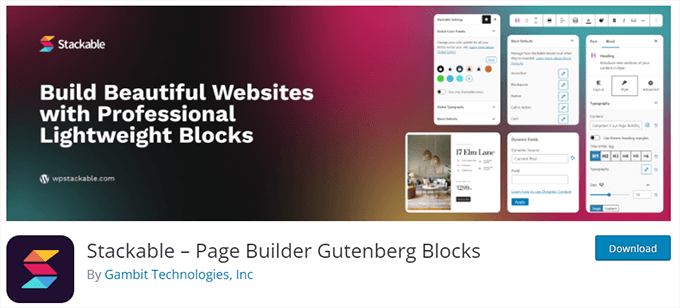
Stackable – Gutenberg Blocks to kolekcja 111111 pięknie zaprojektowanych bloków Gutenberg, które możesz wykorzystać na swojej witrynie internetowej. Zawiera bloki dla kontenera, wpisów, siatki funkcji, akordeonu, ramki z obrazkami, listy ikonek, wezwania do działania i innych.
Aby uzyskać więcej opcji, zobacz naszą pełną listę najlepszych wtyczek blokowych WordPress Gutenberg.
Najczęściej zadawane pytania dotyczące Gutenberga – edytora bloków w WordPressie
Odkąd Gutenberg stał się domyślnym edytorem WordPress, otrzymujemy wiele pytań o to, jak z niego korzystać. Oto odpowiedzi na niektóre z najczęściej zadawanych pytań dotyczących edytora bloków.
1. Co się stanie z moimi starszymi wpisami i stronami w edytorze bloków? Czy nadal mogę je edytować?
Edytor bloków nie ma wpływu na twoje stare wpisy i strony. Nadal możesz je edytować, a edytor bloków automatycznie otworzy je w bloku zawierającym klasyczny edytor.
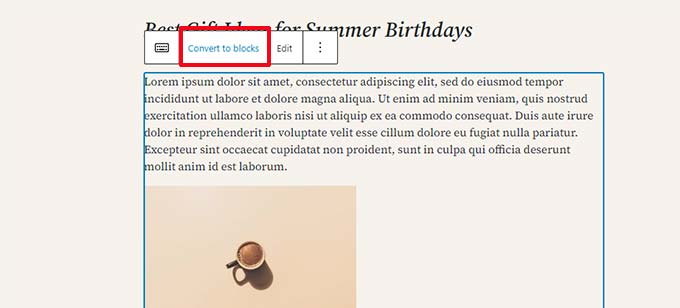
Można je edytować w starym edytorze lub przekonwertować starsze artykuły na bloki i korzystać z edytora bloków.
2. Czy mogę nadal używać starego edytora?
Tak, nadal możesz korzystać ze starego edytora. Wystarczy zainstalować i włączać wtyczkę Classic Editor.
Po włączaniu edytor bloków zostanie wyłączony i będzie można nadal korzystać z klasycznego edytora.
Należy pamiętać, że edytor klasyczny będzie wspierany do 2025 roku. Aby zapoznać się z edytorem bloków, zacznij korzystać z niego już teraz.
3. Co zrobić, jeśli edytor bloków nie działa z używaną przeze mnie wtyczką lub motywem?
Projekt Gutenberg był długo w fazie rozwoju, co dało autorom wtyczek i motywów mnóstwo czasu na przetestowanie swojego kodu pod kątem zgodności [może być też “kompatybilny”].
Nadal istnieje jednak szansa, że niektóre wtyczki i motywy nie będą dobrze współpracować z edytorem bloków. W takim przypadku można zainstalować wtyczkę Classic Editor, poprosić dewelopera o dodanie pomocy technicznej Gutenberg lub znaleźć alternatywną wtyczkę lub motyw.
4. Jak mogę dowiedzieć się więcej o poradach i sztuczkach Gutenberga?
WPBeginner to najlepsze miejsce, aby dowiedzieć się więcej o edytorze bloków w WordPress. Jesteśmy największą witryną z zasobami WordPress w Internecie.
Będziemy publikować nowe artykuły i aktualizować nasze stare zasoby, aby pomóc ci opanować edytor bloków.
W międzyczasie, jeśli masz jakiekolwiek pytania, skontaktuj się z nami, zostawiając komentarz lub korzystając z formularza kontaktowego na naszej witrynie internetowej.
5. Problemy z Gutenbergiem?
Jeśli masz problemy z edytorem bloków WordPress, stworzyliśmy krótki przewodnik po rozwiązywaniu problemów, w którym wymieniliśmy wszystkie typowe problemy z edytorem bloków napotykane przez użytkowników i sposoby ich poprawki.
Film instruktażowy
Jeśli nie preferujesz pisemnych instrukcji, obejrzyj nasz film instruktażowy:
Zasoby bonusowe
Poniżej znajduje się kilka dodatkowych zasób, które pomogą ci efektywniej korzystać z edytora bloków:
- Edytor bloków WordPress a kreatory stron: Jaka jest różnica?
- Jak utworzyć własny blok WordPress (prosty sposób)
- Jak importować / eksportować twoje bloki WordPress Gutenberg (2 kroki)
- Widżety WordPress a bloki – jaka jest różnica? (Wyjaśnienie)
- Kompletny przewodnik dla początkujących po pełnej edycji witryny WordPress
- Najlepsze motywy blokowe do pełnej edycji witryny w WordPress
- Wskazówki dotyczące opanowania edytora treści WordPress
If you liked this article, then please subscribe to our YouTube Channel for WordPress video tutorials. You can also find us on Twitter and Facebook.





ary
I have downloaded Gutenberg plug in but I still see the same classic editor. What I need to do?
WPBeginner Support
If your site is up to date it should be using the block editor by default, you would want to check if you have a plugin enabled to show the classic editor instead.
Admin
Jackson Ndawala
Is there a need for me to add a theme if the block editor can do all the things the theme can do? Please help.
WPBeginner Support
You would still need a theme for WordPress to work for the time being. The theme is for the overall design and styling of your site and you can use the block editor to customize parts of your site.
Admin
Cattie Coyle
I literally just heard about this new “Gutenberg thing” and found your great tutorial – thank you, it will be super helpful once I figure out how to get Gutenberg to appear on my site. I still only have the classic editor (and I don’t have it as a plugin, it’s the way my site has always been), is there something I need to install to be able to see the Gutenberg editor?
WPBeginner Support
You would want to be sure your WordPress site is updated to the most recent version to see it. You would also would want to check if the classic editor plugin is active on your site for why the block editor is not your default editor.
Admin
jo gandomi
Hello
How did you change the background color of the editor?
For me it is white but for you it is a different color
WPBeginner Support
Unless your theme overrides this, the block editor should use the same background color as your content on your site.
Admin
Nikki
Thank you for the I’m informative video. I have been avoiding the new editor because I’ve been using WP for many years and didn’t see the usefulness in learning a new way when there was nothing wrong with the classic editor. I didn’t realize they were discontinuing classic in 2022, so I actually found this in perfect timing. I see there is still a bit of a learning curve, but it’s not as bad as I thought it would be.
WPBeginner Support
Glad our guide was helpful and we hope you enjoy using the new editor
Admin
Michael
This tutorial has really helped me understand what I can do using Glutenberg. Thanks
WPBeginner Support
Glad you found our guide helpful
Admin
Arnold
Hi there,
When I use the classic editor, the toolbar has a setting to choose a font-type from a drop down menu.
How do you change the font-type when using the block editor?
Arnold
WPBeginner Support
It sounds like you mean the Advanced Editor Tools (TinyMCE Advanced) you can add some of those tools back but for changing the font for your site’s visitors you would want to take a look at the recommendations from our article below:
https://www.wpbeginner.com/wp-themes/how-to-add-custom-fonts-in-wordpress/
Admin
Lio
For some mysterious reason the block settings show up below the page (like YoastSEO settings etc.) instead of on the right side of it. What could be the problem?
WPBeginner Support
More than likely your browser is too narrow, if you expand your browser window it should appear on the side again.
Admin
Jay
I am finding the block editor to be quite frustrating right now. This is because I was hoping to begin blog entries with a quote, poem, or song lyric. As I’m typing and hit enter to go to a different line in the poem, I get a new block. How can I do multiple lines without getting a new block for each line whenever I hit enter?
WPBeginner Support
You would want to use shift enter instead of only enter to stay within the same block.
Admin
Lisa Richardson
Finally decided to learn the block editor. Wow! Why did I wait so long? I read this article, then started a new draft page using block editor. So easy. Once I get used to it and learn more writing new pages and post will be so easy and fun! To those still using classic editor, you really need to start learning and using block editor.
WPBeginner Support
Glad you’re liking the block editor and we hope our guide can make the transition a little easier
Admin
Carla
I was wondering if there is a way to edit a block that has been used in multiple posts so that the changes would appear simultaneously?
WPBeginner Support
You would want to use a reusable block for what you’re wanting to do. You can see our guide on it below:
https://www.wpbeginner.com/beginners-guide/how-to-create-a-reusable-block-in-wordpress/
Admin
Marcel
why Gutenberg appears in the list of modules so that it can be installed if when you install WordPress the block editor is the default?
WPBeginner Support
There was a Gutenberg plugin for the block editor from before it was the default editor. You do not need to install the Gutenberg plugin to use the block editor anymore.
Admin
Naureen Amjad
Hi,
Thanks for the detailed article.
Some time ago, I deleted the block editor. How do I re-install it? there are so many Gutenberg plugins, can’t figure out which one is the default editor.
Thanks for your help.
WPBeginner Support
You would want to disable the Classic editor plugin to use the Block editor on your site normally unless you are using a different plugin.
Admin
Dana
Thank you! This was the answer I was looking for LOL. Couldn’t figure out why the block editor wasn’t showing. You all are the best.
Muhmmad Humayoon
Sir, I have to format my text spacing like margin and padding. Which block I should Use?
WPBeginner Support
That would be CSS rather than a specific block, for a starting point you would want to take a look at our guide on inspect element below:
https://www.wpbeginner.com/wp-tutorials/basics-of-inspect-element-with-your-wordpress-site/
Admin
James
Awesome. Very detailed and helpful.
WPBeginner Support
Glad our guide was helpful
Admin
Steve
What is the best way to copy content from MS Word into the Block Editor?
WPBeginner Support
You would want to take a look at our article covering this below:
https://www.wpbeginner.com/plugins/how-to-import-docx-documents-in-wordpress/
Admin
Ayoola Efunkoya
Nice and helpful post. However, I am seriously looking for resources on how to use the new editor with screen readers. Please can you help?
WPBeginner Support
We do not have a recommendation at the moment but we will keep a look out.
Admin
Russ
When I open my page and go to edit it, it ALWAYS first has the block editor tutorial pop up. How do I make this annoying pop up go away permanently so I can just get to my editing?
WPBeginner Support
You may want to ensure that your browser is not preventing cookies from being set when you close that popup for one common reason.
Admin
Sameo
From using this block editor, I realised that there is no way to send global font colour and size for the entire blog. It is super time consuming to change each individual blog.
Is there a way around this ?
WPBeginner Support
For that, you would need to use CSS. We cover CSS in our glossary page below:
https://www.wpbeginner.com/glossary/css/
Admin
Joshua
How do I reduce the visible post by putting ‘read more’ where I want to keep hidden?
WPBeginner Support
For that, you would use the More block
Admin
Colin Burch
Is there a way to index a block? Reduce its width?
WPBeginner Support
It would depend on the specifics you are looking for when you say index. For the width, you can use CSS or columns as the most common methods for what you’re wanting to do.
Admin
Colin
I did not see something I have used often. Example is I have paragraph block where I describe a scripture reference. Then I make another paragraph block to contain the scripture. I would like to indent the scripture block. How would I do that?
WPBeginner Support
For the moment you should be able to use a classic block to add that indent
Admin
Colin
Thanks for reply. Actually, decided to use the ‘quote’ block, though the ‘verse’ block would also work. Both give a little indent. The ‘quote’ puts a vertical bar also.
WPBeginner Support
Glad you found a solution that works for you
Nancy
I’m just starting out on Word Press. Maybe this was the “right” time because I haven’t used the older version or gotten used to it. I’ll start right up w/ the new block editor. This guide was helpful. Thanks.
WPBeginner Support
You’re welcome, glad our guide could be helpful
Admin
Ted Owen
Thannks for such a wonderful article. And thanks for your patience. I tried Gutenberg for a brief period, but had difficulty with one important issue: images surrounded by text were right up against each other, no space at all. Tried to find a way to add padding, but couldn’t find it. So went back to Classic.
But now your article shows how much more there is good about Gutenberg, that I’ll just ask you–how do you add padding (space) between an image and abutting text? If there is a current resolution, will return to Gutenberg in a short minute!
Best, Ted
WPBeginner Support
You could use the media and text block for one method, you may also want to check with your theme’s support to ensure your theme’s styling isn’t part of the reason for this issue.
Admin
Ted Owen
Thank you. Will try it out next post.
Vatsalya Agnihotri
Sir your blog is amazing, I want to ask that if I want to mark my post as featured post in the block editor then how can I do that plz sir tell me
WPBeginner Support
There should be a checkbox in the post’s settings for sticking the post to the top of the blog for what it sounds like you want
Admin
macide
Hi,,Thank you veyr much for your article.
I was prejudiced against the new block editor at first but I am pleasantly surprised that it gives you many more option to transform your pages.
My only problem is that the block editors shows all titles in uppercase at the front end, though the titles on published posts look as they should. Is there any way to fix this so I can see what I’m doing on the editor ?
Thank you in advace.
WPBeginner Support
We do not have a recommendation at this time but as the block editor improves it should start to look more like the front end of your site.
Admin
Kathleen
I have WordPress dot com. I’m trying to use the block editor, but I can’t find where to enter tags and categories. It seems to have disappeared. Any tips? Thanks.
WPBeginner Support
That would be in the document settings, or you could check under the three verticle dots in the top right under options. Our tutorials are for self hosted installations so should the option not be available you would want to reach out to their support.
Admin
Shannon
is there a document that tells me what all these blocks do?
WPBeginner Support
Not at the moment.
Admin
Sarah
I NEED IT OFF AND I NEED IT OFF NOW. I don’t have plugins, I don’t understand. There is no option for classic / a normal editor. How do you go back on the free version? Any time I try to use any plugin even free ones it says I need to upgrade to a paid version of wordpress to use any, even the free plugins, bizarre.
WPBeginner Support
That would be due to your site being on WordPress.com, you are limited to their options for the classic editor as there are differences in WordPress.com and WordPress.org:
https://www.wpbeginner.com/beginners-guide/self-hosted-wordpress-org-vs-free-wordpress-com-infograph/
Admin
Dave Tolbert
Thanks for this article, it’s terrific. So far I like the block editor. But when I want to insert an image in a numbered list it seems that there is no control over where the image appears in the list. Is there a way to control where an image appears in a list block?
WPBeginner Support
If you’re having this issue with multiple blocks then you may want to try using a classic block for creating your list.
Admin
Neal Umphred
Thanks for this easy-to-follow tutorial on Gutenberg.
I just got to “Saving and Reusing Blocks in Gutenberg” and followed all the steps. I reached the page where I can manage my reusable blocks.
Now, how do I get back to my editor?
WPBeginner Support
You would need to manually go back to the page through the posts/page admin area and edit the post again
Admin
Neal Umphred
Thanks—that is what I did!
Keep up the good work: This tutorial has helped me immensely in overcoming my fear of change from the Classic editor to the Gutenberg editor (a much more interesting and classy name that “block editor”).
PS: If you have an in with the Gutenbergers, you might suggest they add a return-to-editor option on that reusable page.
WPBeginner Support
GLad our article could help with your confidence in swapping to the new editor
Senchibald
Dear,
I have a problem with GUTENBERG block on wordpress. The block has suddenly become narrow, it is not all over the page and I do not have enough space. How to fix this problem?
WPBeginner Support
To start, if it is not a block added by a plugin, you would want to reach out to your theme’s support to ensure this isn’t a styling error in the theme.
Admin
Lily Girma
My blocks are all jumbled up when I try to create a new post and I can’t even write. Please help? I have everything updated so am not sure why it’s doing this. I am in Chrome.
WPBeginner Support
There are a few possible reasons, to start with you could try a different browser to see if an addon or similar is causing a problem. If that doesn’t fix the block location you could check for a theme or plugin conflict using our guide here: https://www.wpbeginner.com/beginners-guide/beginners-guide-to-troubleshooting-wordpress-errors-step-by-step/
Admin
Steve Smith
This new block system is awful.
I can’t do the basic of having a thumbnail image to the left and a h2 heading text centred inline at the top next to it with a h4 heading below.
This was the most basic of things to do with the old, superior system.
I have the illusion of more control but the reality is I have more options that achieve less.
I hope I can go back to classic style because this means i can’t add to my site anymore.
Just appalling.
WPBeginner Support
It is a learning process for the new editor, for what you’re wanting you may want to try the column block to create that.
Admin
Karen Fontaine
After reading the tutorial, and want to uninstall the plugin for classic editor. However, I have a post that was written in both classic and block–the fonts are different and it looks weird. When I switch to block view one of the blocks says “contains unexpected or invalid content”. And then asks to switch to HTML.
If I uninstall the plugin will I have to recreate this content?
WPBeginner Support
You will likely need to set up the content that was modified to HTML to get your styling back but for the most part, the content should still be there.
Admin
jill
is there a comprehensive list of the block symbols and what each one does?
WPBeginner Support
Not at the moment, as plugins add blocks there will also be more blocks in your list but the blocks should state their name below their symbol to give you an idea on what they’re used for
Admin
Annette Abrahamsen
This is a great intoduction! I’ve learned a lot..
However I can’t seem to find a guide on how to make a link block.
I need to link from my site to another site just using a block with a link.
The only option I get is to edit my permalink
Any ideas, you guys??
WPBeginner Support
When you edit text in a paragraph block by highlighting it, you should be able to use the small new toolbar to add a link.
Admin
DaveM
First started using WP V2.6 way back in 2008, and converted my own developed php sites, to use WP as a CMS. It’s certainly come a long way since then. While Gutenberg certainly seems to provide far better work-flow UI, which is packet with goodies, where once you either had to code yourself, or adopt a plugin, I must admit, even as seasoned WP user, the new interface has me stumped more often than not. It’s just another learning curve. So thanks for introduction, tips and guidance. I’ll use this inform to get handle on it! Cheers.
WPBeginner Support
Thanks for sharing how you feel about Gutenberg, as it improves hopefully it should get easier to use
Admin
Michael Lowing
I was pleased to find I could insert a table using the block editor. I populated the cells with codes each of which I wanted to link to media content. However, I could not see any easy way to do this. I could have linked to the URL in each case but this is long-winded. Obviously it would be better to be able to add media content directly from the block editor – have I been stupid and missed something?
WPBeginner Support
For the moment that is a limitation with the table block, the closest would be creating a column block to insert media blocks as another option.
Admin
Jonathan
Since I updated WordPress,I was alerted that “Connection lost” I disabled classic editor plugin before it was resolved. Please is there any way I can use the classic editor and disable the Block editor. Since the block came, my WordPress app always notify me of Generic error when I publish. what is the problem of the app too?
WPBeginner Support
You would want to reach out to the app’s support and let them know about that issue for them to take a look into what could be the issue.
Admin
Curt Byers
This was an incredibly helpful tutorial.
But I don’t think I saw a solution to my inability to center title text. Which is ridiculous.
But the side bar format options you get with Headings, which have a CENTER option disappears with Title and the overhead format bar, which with Images has a CENTER option too. also disappears. This is the most important and visible feature on a page and WordPress has seemed to go out of its way to prevent a very common formatting choice. Any help? Thanks again for your service to the WordPress community.
WPBeginner Support
If you do not see the option to center the text then you should be able to click the three dots in the top right to enable the top toolbar. With that enabled, you should have the option to center the text in the paragraph block while the block is selected.
Admin
stephen hart
Is there an easy way to navigate between blocks on a page. For example if I am reading something in the first block on the page and next want to go to a block further down the page is there an easy way to jump to a different block or do you just have to scroll down the page?
WPBeginner Support
For the moment you would want to scroll down the page
Admin
Jeffrey Christian
I loathe the new formatting of WP, so much that I am changing my blog host. This is not more user friendly. I used to be able to post easily, then add a video from my library. Now, it defaults to the new block format, which is dreadful, and which I can’t change, and when I frustratingly finish the blog post, I can’t add my video media. WP is always updating to make blogging a more infuriating experience. What a shame.
WPBeginner Support
If you would like to stay on WordPress there is the option to revert to the classic editor using the method in our article here:
https://www.wpbeginner.com/plugins/how-to-disable-gutenberg-and-keep-the-classic-editor-in-wordpress/
Admin
Nesdon
Although this infuriating problem is universal to all software UIs. It often feels like as soon as you get up on to the flat part of the learning curve, they update the UI and throw another climb in your face.
I guess knowing how long to wait and how far to push design changes is the key to acceptance of progress among the user base. Indeed, Gutenberg is a tall step that some folks will not want to climb. But there were so many inscrutable legacy elements that they put off addressing for so long, it may have been unavoidable.
I’m struggling as well, especially dealing with older sites using lots of shortcodes, but hoping once I get over the hump, there will be a beautiful wide meadow on the other side.
Larry Dean
I think it would be useful to have the ability to save a group of blocks as one and not just the individual blocks. That way, once you have your post page like you want it, it can be reused. This would be particularly useful for those of us who don’t really change the structure of each post and don’t really need that degree of flexibility.
WPBeginner Support
That could certainly be something to look into for the future as Gutenberg improves
Admin
A O'Brien
Hi! Is there a way to change the size of a cover block? I want it to be a half page width so I can have two next to each other but can’t find anything to support this.
Thank you!
WPBeginner Support
You may want to use the column block for what it sounds like you’re wanting.
Admin
RK
Is there an option to disable blocks and revert back to the old editor format?
Gutenberg Block sucks, and I don’t want to compromise the quality and speed of my work while they spend the next couple of years improving it.
WPBeginner Support
You can revert to the classic editor using one of the plugins in our article here: https://www.wpbeginner.com/plugins/how-to-disable-gutenberg-and-keep-the-classic-editor-in-wordpress/
Admin
BOSS
The block is actually still rubbish. how to change block height??????
WPBeginner Support
The block editor is slowly trying to improve, your block should change its height based on the content added in the block
Admin
Danielle
I’m a total newb to WP and I am currently using the 2019 theme. All I’m trying to do is add an excerpt so that the full posts don’t show up on the home page. For the life of me I can’t figure out how to do this. I tried using the “excerpt” text box found in the right nav of the document editor. Any help here would be great. Thanks!
WPBeginner Support
The theme may not support excerpts, you could try adding the more block or the read more depending on if you’re using the classic or block editor to see if that solved the issue
Admin
David Brittan
Danielle, maybe you want the “More” tool, listed under Layout Elements. It lets you add a “Continue reading” link after the first (or whichever) paragraph of a post.
nick
Is there a way to reduce space between two blocks?
WPBeginner Support
If you mean on the front end of your site, you would normally need to edit that using CSS
Admin
Lori | Choosing Wisdom
When I look at my paragraph block I don’t see the same options as you’ve shown here. I can’t change the color of a font and there are preset colors in the color settings under custom styles for background colors. Is there something I need to turn on to access this option in the paragraph block?
WPBeginner Support
You shouldn’t need to enable anything, you may want to ensure a plugin or your theme isn’t removing these options
Admin